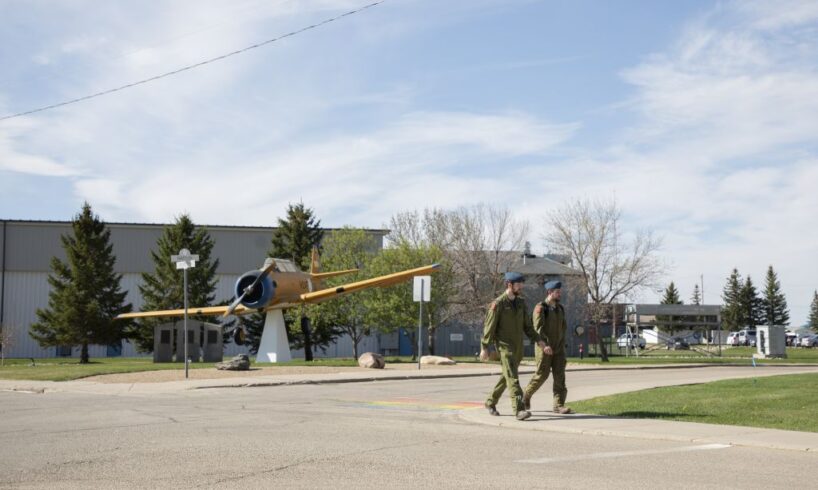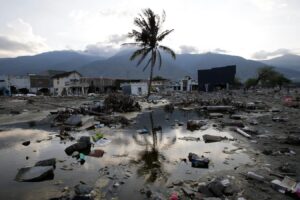
The slogan for the city of Moose Jaw, Sask., is “Canada’s Most Notorious City,” stemming from historical connections to Al Capone. The Canadian Armed Forces base nearby — home of the Snowbirds — is surrounded by a patchwork of quintessential Saskatchewan cropland and homes.
As one of the city’s major employers, the base employs about 1,000 active military service members and federal public servants. Over the last year, some of them have begun to testify that they believe the workplace they have dedicated their lives to is making them very sick — in some cases, terminally so.
These workers have attempted to get answers from their employer, the Department of National Defence, but say they have faced skepticism, criticism and retribution for asking questions and speaking out. Still, they are determined to fight for accountability.
Staff vehicles and a plane on display at 15 Wing Moose Jaw, a Canadian Forces Base near Moose Jaw, Sask. The site, like many military bases, has environmental contaminants, including PFAS from things like solvents, fuels and firefighting foam. Photo: Amber Bracken / The Narwhal
“Because you sign on that dotted line, the expectation is you’re going to die for your country. Well, dying doesn’t mean I should get sick because of a chemical that [the government] didn’t clean up properly,” one veteran, now undergoing chemotherapy for a rare form of breast cancer, told The Narwhal. Two of her colleagues and her former supervisor have died of breast cancer.
Many questions about the cluster of illnesses remain. Here’s what we know, so far.
1. There are thousands of contaminated sites on the federal inventory
Contamination on federal sites is an issue across Canada. Thousands are listed on the federal contaminated sites inventory, including military bases with offices, hangars and warehouses on top of unremediated contamination sites.
Last week, The Narwhal published an investigation honing in on one military base: CFB Moose Jaw in southern Saskatchewan.
It’s listed on the federal inventory of contaminated sites and numerous sites on the base — aircraft hangars, former convenience stores and landfills — are polluted. Military bases are also often home to housing for service members and their families.
2. PFAS (forever chemicals) are just one kind of contaminant among many at CFB Moose Jaw
One of the most attention-grabbing classes of chemicals found on some contaminated sites, including CFB Moose Jaw, are PFAS, or per- and polyfluoroalkyl substances.
PFAS have been making headlines for the last several years for contaminating drinking water near military bases. They are found or suspected on more than 100 federal sites in Canada, in large part from firefighting foam that National Defence used to train military and civilian firefighters across Canada from the 1970s to the early 2010s.
The United States Environmental Protection Agency lists numerous potential health risks of exposure to PFAS from fertility issues to cancer. The impacts aren’t limited to people. Ecosystems are affected, too, whether through reducing seed germination or building up in the organs of other creatures in the food chain.
But PFAS aren’t the only concern.
Gord King lays out some of his plaques and service momentos from his service at his home in Moose Jaw, Sask. King worked at 15 Wing Moose Jaw Canadian Forces Base for 22 years and wonders if environmental contamination could have contributed to his stage 2 prostate cancer. Photo: Amber Bracken / The Narwhal
Other chemicals on the long list of contaminants near the CFB Moose Jaw buildings are less widely known. There are BTEXs, a group of petroleum hydrocarbons, including benzene and toluene. They also have a long list of health impacts associated with them, from heart problems to cancers to neurological issues.
Another contaminant found at CFB Moose Jaw is a class of chemicals — present in coal, crude oil and gasoline — called PAHs, or polycyclic aromatic hydrocarbons, some of which are also considered to be cancer-causing. Oh, and then there’s the asbestos.
3. Canadian Armed Forces employees say dozens of their colleagues have become sick with cancers, neurological issues and more
Shaunna Plourde moved into housing at CFB Moose Jaw when she was pregnant with her first baby. Her husband, an aircraft engine technician, was employed at the base and she got a job there, too.
In December she told a public hearing of the Standing Committee on National Defence that it wasn’t long before she began experiencing medical issues.
Then, after seven years on base, Plourde was diagnosed with a neurological disorder. In 2017, she had an emergency hysterectomy.
“Since this time, four other women I work with have all needed to have this procedure. Many of us were employed in the same building — Building 143,” Plourde told the committee. “A simple, yet alarming, question started being discussed in the building I work in: ‘Do you think our building is safe?’ ”
She’s not alone in her concerns, as other employees — with early-onset Parkinson’s, prostate cancer, a rare form of breast cancer and other diseases — have come forward to ask the same question.
Erin Zimmerman, a Snowbird veteran who also worked as a civil servant, was diagnosed with early-onset diagnoses of Parkinson’s disease. She’s concerned contamination is causing a rash of negative health impacts for people working and living on base. Photo: Amber Bracken / The Narwhal
Erin Zimmerman, a Snowbirds veteran who also worked as a civil servant at CFB Moose Jaw, has compiled a list of nearly 200 illnesses and dozens of obituaries of her colleagues.
“I learned that while I was serving, and even during my pregnancy, I’ve been working on, or next to, a contamination site,” Zimmerman told The Narwhal. “I also heard that others in our building were experiencing serious illnesses.”
4. The Canadian Armed Forces says ‘routine testing had not indicated issues’
For its part, the military says its activities can have effects on soil and water, but it strives “to minimize risks to Canadians and the environment,” adding it is committed to the health and safety of military personnel and surrounding communities, as well as to “responsible environmental management.”
Responding to questions from The Narwhal, a spokesperson wrote the military “conducts regular monitoring programs at bases and wings to assess environmental conditions and identify potential concerns. Although routine testing had not indicated issues, following community concerns, we undertook extensive testing [in Moose Jaw] to ensure transparency and diligence in addressing concerns.”
The military has been engaging in activities that create contamination for decades, but it’s far from the only source of contamination in Canada — it’s just one with public records. Some experts say the main reason we know so much about the contaminants present on military sites is because the federal government keeps pretty good records.
5. People who live near CFB Moose Jaw fear the contamination spreading
“What is in the workplaces tends to get out,” said Christine Oliver, a doctor who specializes in occupational and environmental health.
Health Canada says some contaminants can travel long distances through soil, water and air: “PFAS can be found in freshwater and drinking water in areas that are far away from where they entered the environment,” the department says on its website.
A farmer’s field butts up against the Canadian Forces Base near Moose Jaw. Photo: Amber Bracken / The Narwhal
It’s impossible to quantify if or how much contamination has seeped off the base without publicly available studies, but some nearby farmers and residents are beginning to worry.
“I have obvious neurological problems,” one resident told The Narwhal. He was diagnosed with multiple sclerosis and both his parents suffer neurological issues. “It just puts more questions into our minds, like, ‘Is that a potential factor?’ … I wouldn’t think a chain link fence would stop contaminants from moving around.”





